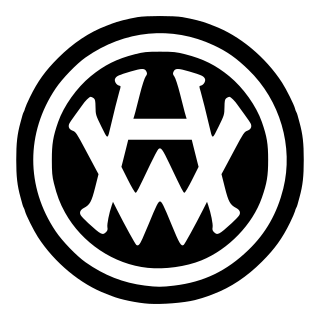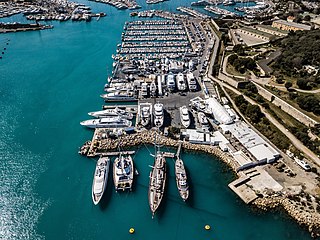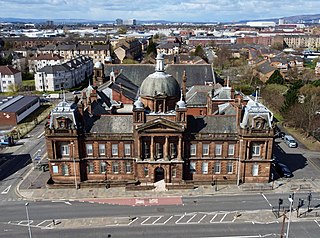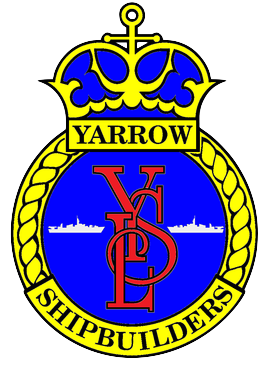
Harland & Wolff is a British shipbuilding and fabrication company headquartered in London with sites in Belfast, Arnish, Appledore and Methil. It specialises in ship repair, shipbuilding and offshore construction. Harland & Wolff is famous for having built the majority of the ocean liners for the White Star Line, including Olympic-class trio – RMS Olympic, RMS Titanic and HMHS Britannic. Outside of White Star Line, other ships that have been built include the Royal Navy's HMS Belfast; Royal Mail Line's Andes; Shaw, Savill & Albion's Southern Cross; Union-Castle's RMS Pendennis Castle; P&O's Canberra; and Hamburg-America's SS Amerika of 1905. Harland and Wolff's official history, Shipbuilders to the World, was published in 1986.

A shipyard, also called a dockyard or boatyard, is a place where ships are built and repaired. These can be yachts, military vessels, cruise liners or other cargo or passenger ships. Compared to shipyards, which are sometimes more involved with original construction, dockyards are sometimes more linked with maintenance and basing activities. The terms are routinely used interchangeably, in part because the evolution of dockyards and shipyards has often caused them to change or merge roles.

Govan is a district, parish, and former burgh now part of south-west Glasgow, Scotland. It is situated 2.5 miles (4.0 km) west of Glasgow city centre, on the south bank of the River Clyde, opposite the mouth of the River Kelvin and the district of Partick. Historically it was part of the County of Lanark.
Cammell Laird is a British shipbuilding company. It was formed from the merger of Laird Brothers of Birkenhead and Johnson Cammell & Co of Sheffield at the turn of the twentieth century. The company also built railway rolling stock until 1929, when that side of the business was separated and became part of the Metropolitan-Cammell Carriage & Wagon Company.

Vickers Shipbuilding and Engineering, Ltd (VSEL) was a shipbuilding company based at Barrow-in-Furness, Cumbria in northwest England that built warships, civilian ships, submarines and armaments. The company was historically the Naval Construction Works of Vickers Armstrongs and has a heritage of building large naval warships and armaments. Through a complicated history the company's shipbuilding division is now BAE Systems Submarine Solutions and the armaments division is now part of BAE Systems Land & Armaments.

The Aircraft and Shipbuilding Industries Act 1977 is an Act of the Parliament of the United Kingdom that nationalised large parts of the UK aerospace and shipbuilding industries and established two corporations, British Aerospace and British Shipbuilders (s.1).

Yarrow Shipbuilders Limited (YSL), often styled as simply Yarrows, was a major shipbuilding firm based in the Scotstoun district of Glasgow on the River Clyde. It is now part of BAE Systems Surface Ships, owned by BAE Systems, which has also operated the nearby Govan shipyard since 1999.

The Fairfield Shipbuilding and Engineering Company, Limited was a Scottish shipbuilding company in the Govan area on the Clyde in Glasgow. Fairfields, as it is often known, was a major warship builder, turning out many vessels for the Royal Navy and other navies through the First World War and the Second World War. It also built many transatlantic liners, including record-breaking ships for the Cunard Line and Canadian Pacific, such as the Blue Riband-winning sisters RMS Campania and RMS Lucania. At the other end of the scale, Fairfields built fast cross-channel mail steamers and ferries for locations around the world. These included ships for the Bosporus crossing in Istanbul and some of the early ships used by Thomas Cook for developing tourism on the River Nile.
BAeSEMA was a naval technology joint venture between British Aerospace and the French Sema Group. The company was formed in 1991 and dissolved in November 1998 when BAe purchased SEMA's 50% share.
BAE Systems Marine Limited was the shipbuilding subsidiary of BAE Systems, formed in 1999, which manufactured the full range of naval ships; nuclear submarines, frigates, destroyers, amphibious ships.

John Brown and Company of Clydebank was a Scottish marine engineering and shipbuilding firm. It built many notable and world-famous ships including RMS Lusitania, RMS Aquitania, HMS Hood, HMS Repulse, RMS Queen Mary, RMS Queen Elizabeth and Queen Elizabeth 2.
Appledore Shipbuilders is a shipbuilder in Appledore, North Devon, England.

Ferguson Marine Limited is a shipbuilding company whose yard, located in Port Glasgow on the Firth of Clyde in Scotland, was established in 1903. It is the last remaining shipbuilder on the lower Clyde and is currently the only builder of merchant ships on the river. For some years the company's mainstay has been Roll-on/roll-off ferries, primarily for Caledonian MacBrayne (CalMac), including a series of innovative hybrid diesel-electric/battery-powered vessels. Beset with difficulties since 2018 over their latest two CalMac ferries, Fergusons' largest ever vessel, the shipyard was nationalised in December 2019. It is now classified as an executive non-departmental public body of the Scottish Government.
Kvaerner Govan Ltd (KGL), located at Govan in Glasgow on the River Clyde, was a shipyard subsidiary formed in 1988 when the Norwegian group Kværner Industrier purchased the Govan Shipbuilders division of the nationalised British Shipbuilders corporation. Prior to the Govan Shipyard's nationalisation in 1977, as a result of the Aircraft and Shipbuilding Industries Act, it had been operated by Govan Shipbuilders Ltd, which emerged from the collapse of the previous Upper Clyde Shipbuilders (UCS) joint venture in 1972. Prior to the formation of UCS in 1968, the Shipyard was operated by the Fairfield Shipbuilding and Engineering Company, which had a history extending back to 1834.
BAE Systems Maritime – Naval Ships is a wholly owned subsidiary company of BAE Systems, specialising in naval surface shipbuilding and combat systems integration. One of three divisions of BAE Systems Maritime, along with BAE Systems Submarines and BAE Systems Maritime – Maritime Services, it is the largest shipbuilding company in the United Kingdom, one of the largest shipbuilders in Europe, and one of the world's largest builders of complex warships.

A&P Group Ltd is the largest ship repair and conversion company in the UK, with three shipyards located in Hebburn, Middlesbrough and Falmouth. The company undertakes a wide variety of maintenance and repair work on commercial and military ships with projects ranging from a two-day alongside repair period through to multimillion UK pound conversion projects lasting for a year or more.
John G. Kincaid & Company was a major British marine engine manufacturer based at the mouth of the River Clyde in Greenock, Inverclyde, Scotland.











